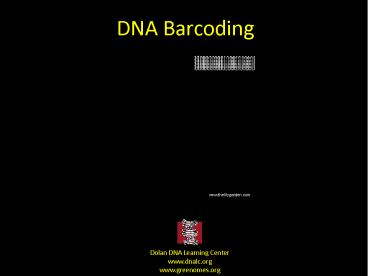DNA Barcoding PowerPoint PPT Presentation
Title: DNA Barcoding
1
DNA Barcoding
www.thelilygarden.com
Dolan DNA Learning Center www.dnalc.org www.greeno
mes.org
2
(No Transcript)
3
What is plant DNA barcoding and why is there a
need for it?
DNA barcoding identifying species using short,
standardized gene region(s)
Just as the UPC label identifies a product, a
short DNA sequence, shown here schematically,
can be an identifier for species, a DNA barcode.
4
(No Transcript)
5
How Barcoding works
Plants are sampled DNA is
extracted Barcode amplified
(or Animal)
ACGAGTCGGTAGCTGCCCTCTGACTGCATCGAATTGCTCCCCTACTACGT
GCTATATGCGCTTACGATCGTACGAAGATTTATAGAATGCTGCTAGCTGC
TCCCTTATTCGATAACTAGCTCGATTATAGCTAC
Sequenced DNA is compared with plants in a
barcode database
6
How many species can you name?
How many Animals did you name? How many
mammals? How many plants? How many insects?
Dog Canis lupus familiaris
Shark Ginglymostoma cirratum
Beetle Popillia japonica
Cat Felis catus
Oak Tree Quercus alba
7
One-quarter of samples mislabeled, all as more
expensive or more desirable fish
Mislabeling in 6 of 10 grocery stores/fish
markets, and 2 of 3 restaurants
FishBase John Casselman
Range map FishBase
8
Problem 1 No one know how many species there are.
9
Vertebrates Species
Mammals 5,490
Birds 9,998
Reptiles 9,084
Amphibians 6,433
Fishes 31,300
Total 62,305
Invertebrates Species
Insects 1,000,000
Mollusks 85,00
Crustaceans 47,000
Corals 2,175
Arachnids 102,248
Total (others) 1,305,250
Plants Species
Angiosperms 281,821
Gymnosperms 1,021
Ferns and Allies 12,000
Mosses 16,236
Green and Red Algae 10,134
Total 321,212
- There are currently between 1.5 and 2 million
described species - It is estimated that this number may represent as
little as half of the true number of species - Perhaps more than 1/3 of all species are
threatened - (IUCN Red list version 2010.1)
10
Problem 2 Even though there are millions of
species, there is also a lack of agreement on
what a species means.
11
- Defining what species are is a
- Complex task
- Dependent on many factors
- Interbreeding capabilities
- Morphological variation
- Ecological niche
- Genetic similarities
Canis lupus (familiaris)
Canis lupus
Anas platyrhynchos
12
- Choosing a DNA
barcode - There are many criteria that go in to
selecting an appropriate region that can
serve as a DNA barcode.
Three of them include - Universality
- Robustness
- Discrimination
- Why are these three criteria important?
13
-
Discrimination - Barcoding regions must be different for each
species. Ideally you are looking for a single
DNA locus which differs in each species. - Oppositional Goals
- Each loci must be different for each species
- Although loci must be different, they must be
similar enough that - they can be amplified by PCR, aligned and
compared
14
Fail Sequence is completely conserved, good for
PCR, but uninformative as barcode
Fail Sequence shows no conservation, impossible
for PCR, but good as barcode
Win Sequence shows some (ideally 70)
conservation, good for PCR, good as barcode
15
-
Universality - Since barcoding protocols (typically) amplify
a region of DNA by PCR, you need primers
that will amplify consistently. - Once you have a candidate locus (loci) that seem
discriminatory, do these loci (possibly genes,
but possibly non-coding DNA) exist in in
virtually all of the species you wish to
barcode? - Will you be able to find PCR primers that can
amplify across many species, despite mismatches?
16
-
Robustness - Since barcoding protocols (typically) amplify
a region of DNA by PCR, also need to select a
locus that amplifies reliably, and sequences
well. - PCR is very sensitive to the chemistry involved
(types of enzymes, concentration of reagents,
cycling parameters, etc. - The amplified PCR product must also be sequenced.
Sanger sequencing is sensitive to highly
repetitive DNA.
17
DNA Barcoding Plants vs. Animals
Finding a DNA locus that possesses all of these
qualities (Discrimination, Universality,
Robustness) was relatively easy in animals. The
animal barcode of choice Is the mitochondrial
gene cytochrome c oxidase I (COI).
18
Based on recommendations by a barcoding
consortium (Concortium for the Barcode of Life,
plant working group) the chloroplast genes rbcL
and matK come very close to being ideal
candidates for universal plant barcodes. Like
any barcode loci that could be chosen, there will
is always a possibility of failure to make a
reasonably definitive identification of a
particular specimen.
19
Future Norm?
- A taxonomic GPS
- Link to reference database
- Usable by non-specialists.
20
ACGAGTCGGTAGCTGCCCTCTGACTGCATCGAATTGCTCCCCTACTACGT
GCTATATGCGCTTACGATCGTACGAAGATTTATAGAATGCTGCTAGCTGC
TCCCTTATTCGATAACTAGCTCGATTATAGCTACGATG
Try your hand, at amplifying the DNA of plants
you can find around you. If possible Try to
identify the plant first, and then see if the
sequence matches you get can confirm your
identification.

